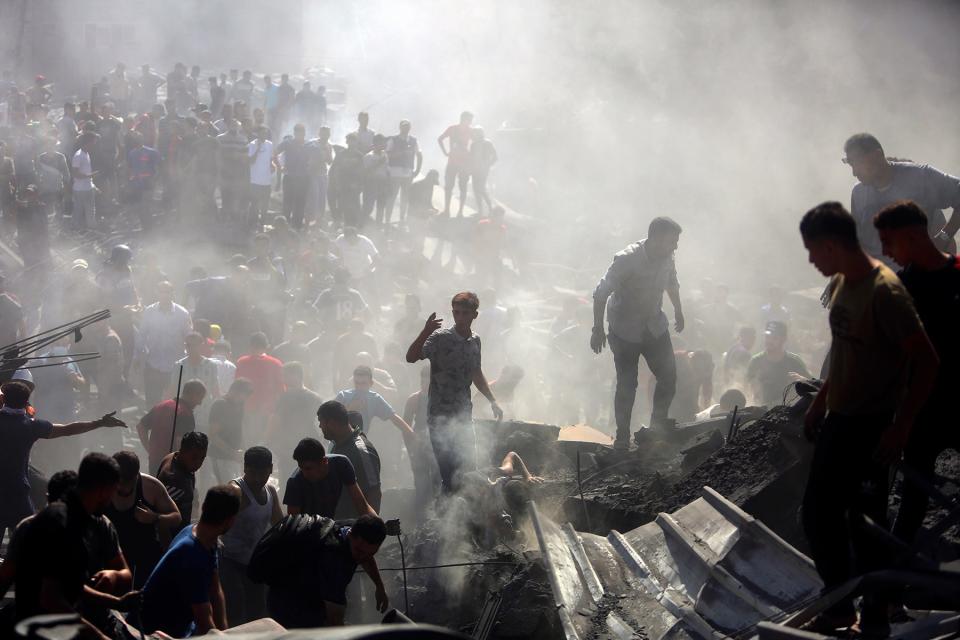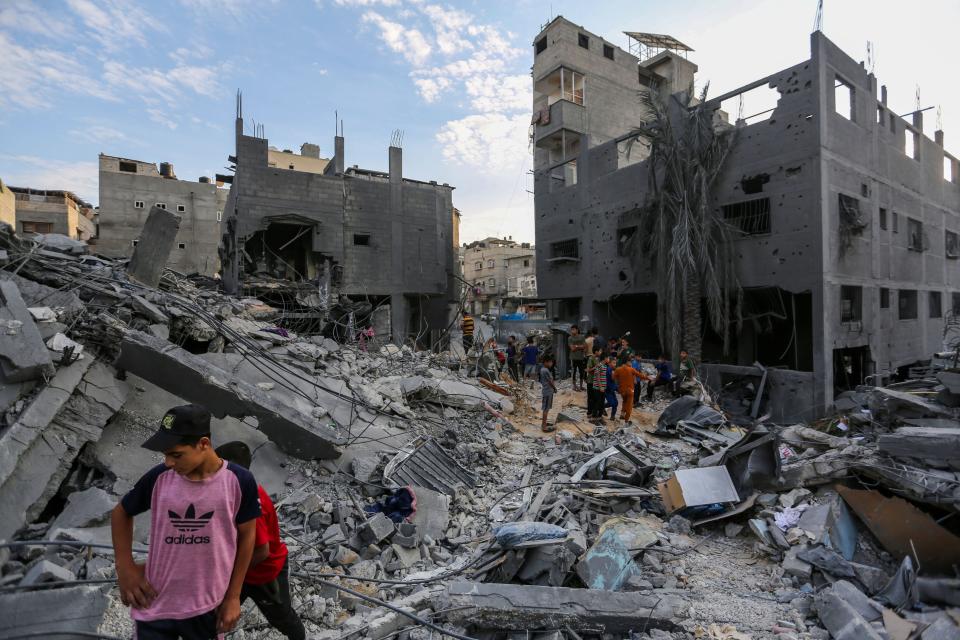Biden's told Israel to 'operate by the rules of war.' But a ground invasion is bloody, fraught and expensive
- Oops!Something went wrong.Please try again later.
WASHINGTON — Israel’s expected invasion of the Gaza Strip will be bloody, fraught with the physical and moral hazards of urban warfare – and the potential to spill over into the Middle East and entangle U.S. troops – current and former U.S. officials say.
In response to the Hamas attacks on Oct. 7 that killed 1,400 people, Israel appears poised to launch its counterattack with an overwhelming advantage in conventional weapons. Israeli tanks and armored personnel carriers, operated by experienced troops, will be backed by sophisticated warplanes that have already bombarded Gaza for days. Militants in Gaza will likely counter with tactics that killed and maimed hundreds of U.S. troops in Iraq – sophisticated improvised explosive devices supplied by Iran that can slice through armor.
How the fighting is expected to unfold, why Gaza is so dangerous for civilians and combatants, and what’s at stake for the tens of thousands of U.S. troops stationed in the Middle East are topics of discussion at the highest levels. The stakes are high for President Joe Biden: he has a historic $100 billion funding request tied up in Congress, he's trying to avoid a conflagration that embroils U.S. troops. Not to mention, the fate of the 2024 election; where Americans are more worried about the economy and how being engulfed in a new proxy war could affect them.
Recent moves by the Pentagon underscore the threat: Two aircraft carriers, with dozens of warplanes, along with their escort vessels have been sent to region; ground-based fighters and attack planes have been massing at U.S. bases in the Middle East; and Defense Secretary Lloyd Austin put thousands of troops on short tethers, ordering them to prepare to deploy on short notice.
Late Thursday, U.S. warplanes pounded two targets in eastern Syria used by Iran's Islamic Revolutionary Guard Corps and affiliated militia groups. The U.S. airstrikes came in response to missile attacks on bases in the region housing U.S. troops and contractors. Those attacks resulted in the death of a U.S. civilian contractor who had a heart attack and resulted in minor injuries to 21 troops.
Austin, in a statement, sought to separate the operation from the fighting between Israel and Hamas and urged adversaries not to mount attacks that could spark a broader war.
“The concern that the conflict will spread remains acute,” said Mark Quantock, a retired Army general and intelligence chief for U.S. Central Command.

Preparing to invade Gaza
Israel has been pounding targets in the Gaza Strip from the air continually since Oct. 7. In recent days, Israeli tanks have made brief incursions into the Hamas-controlled territory. Meanwhile, the Pentagon continues to ship anti-aircraft missiles and ammunition to Israel as it masses troops and armor on the border with Gaza. Senior U.S. military officers have been advising their Israeli counterparts.
“They're giving them real-life experiences that they had in Mosul in Iraq,” Sen. Jack Reed, D-Rhode Island, and chairman of the Armed Services Committee, said in an interview after returning from Israel. “We learned some lessons the hard way, and we’re trying to give them the benefit of our suffering, sacrifice and eventual success.”
Iraqi troops, backed by U.S. airstrikes and advisers, took nine months to root out ISIS terrorist from Mosul. One key lesson from Mosul was the necessity of providing safe evacuation routes for civilians and providing medical care.
Gaza will be more challenging, Reed said.
“This project is much more complicated given the sheer size and the potential opposition,” Reed said.
Gaza and the nightmare of urban warfare
Gaza is home to 2.3 million people on a strip of land about the size of Las Vegas or twice that of Washington, D.C.
Israel will continue gathering intelligence on Hamas, especially its network of tunnels that can be used to store weaponry and launch ambushes by its estimated 30,000 fighters, Reed said. Troops are being briefed on the findings and what to expect they cross the border.
Hamas mounted the Oct. 7 attacks in part to lure Israeli forces into Gaza where they can use tunnels for ambushes, Reed said. They’re also likely to use civilians, and perhaps hostages, as shields to prevent Israeli troops from firing on their positions.
“It can be extremely bloody because the advantages that any modern military state has – long-range tank fires, precision weapons -- those are great in the open,” Reed said. “But when you're on a city street and you can only see 50 meters, the guy with a sniper rifle hidden someplace has just as much of advantage.”
Another lethal hazard for Israeli troops, Iranian-supplied improvised explosive devices. IEDs were the weapon of choice for outgunned insurgents fighting U.S. troops in Iraq and Afghanistan. Iran supplied insurgents in Iraq with a particularly lethal version known as explosively-formed penetrators. The projectiles from the bombs can slice through armor and spray molten metal inside a combat vehicle. The weapons claimed the lives of hundreds of U.S. troops in Iraq.
“What worries me are Iranian made EFPs,” said Scott Murray, a retired Air Force colonel and intelligence officer with extensive experience in the Middle East. “Just nasty, nasty. Terrible way to die. There was really nothing we could do about them. We spent a lot of time in 2007, ’08, tracking them.”
Iran has been a principal backer of Hamas, supplying it with weaponry for years.
The imperative and challenge to protect civilians and hostages
The estimated number of Hamas militants is a fraction Gaza’s population. Sorting out combatants is a devilish task. It’s a war crime to intentionally target civilians. But that doesn’t preclude attacks on legitimate military targets that wound or kill civilians.
“One the most legally complex operations in warfare – rooting out enemy fighters operating from a densely populated urban area – is compounded in this instance by the fear of harming the hostages, not to mention dealing with an enemy quite willing to use human shields, including Palestinian civilians,” said Charles Dunlap, an expert on military law at Duke University and retired Air Force general. “Another complication is determining in the chaos of combat who is a terrorist fighter, given they may dress identically to civilians and embed themselves among civilians.”
The Pentagon’s Law of War Manual details how civilians can lose legal protection, Dunlap said. Placing IEDs, for example, or supplying Hamas fighters with ammunition could make them lawful targets.
The law of armed conflict also accepts that civilians may be killed or wounded in lawful attacks, Dunlap said. Israel might legitimately attack a target, such as missile site that targets Israel, that causes civilian casualties.
“Regardless, commanders must still take all feasible actions to protect civilians and civilian objects,” he said.
With militants fighting in densely populated areas, and from tunnels beneath civilian buildings, the most feasible option may be evacuation to southern Gaza, Dunlap said. Israel has called for that type of evacuation.
“Still, even the most legally scrupulous military operation in an area like Gaza carries very serious potential for significant unintended civilian casualties,” Dunlap said.
The role of U.S. troops
The White House has asked Congress for more than $10 billion to support Israel, triple the annual military aid package. Air defense, like the Iron Dome interceptor system, is Israel’s most urgent need, Reed said.
So far, the Pentagon and White House support for Israel has been an increasing flow of arms and the growing presence of a growing armada of warships and warplanes in the Middle East.
“While the U.S. is certainly reticent of being dragged into a widening conflict, the strong U.S. messaging and movement of U.S. forces to in the region to date, is likely designed to do two things,” Quantock said.
First, it’s meant to prevent further escalation from Iran and its proxy forces, Quantock said. Second, should deterrence fail, provide a breadth of military options for the White House.
“These options likely run the gamut – from simply continuing to provide aid to Israel to conducting decisive kinetic responses,” Quantock said.

This article originally appeared on USA TODAY: Israel's ground invasion of Gaza is hazardous for civilians, Biden

